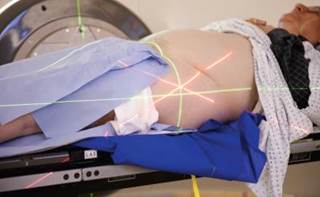Prostate Cancer Death Risk Higher After External Beam Radiation Therapy (EBRT) than Surgery13/10/2014  External beam radiation therapy is associated with greater 10-year prostate cancer-specific mortality than radical prostatectomy across a range of nomogram-predicted risks of biochemical recurrence, according to researchers. In a study of 13,803 men who underwent radical prostatectomy (RP), external beam radiation therapy (EBRT), or brachytherapy from 1995 to 2008, investigators led by Andrew J. Stephenson, MD, of Cleveland Clinic, calculated the 5-year progression-free probability (5Y-PFP) for each patient based on the treatment received using a validated treatment-specific nomogram for predicting biochemical recurrence (BCR). The 10-year prostate cancer-specific mortality (PCSM) rates associated with EBRT and RP were 3% and 0.9%, respectively, among patients with a 5Y-PFP greater than 75%; 6.8% and 5.9%, respectively, for those with a 5Y-PFP of 51%-75%; 12.2% and 10.6% for those with a 5Y-PFP of 26%-50%; and 26.6% and 21.2% for those with a 5Y-PFP of 25% or less, Dr. Stephenson's group reported online ahead of print in European Urology. After adjusting for nomogram-predicted 5Y-PFP, EBRT was associated with a significant 50% increased risk of PCSM versus RP. The investigators found no significant difference in PCSM risk between brachytherapy and RP, although they acknowledged that patient selection factors and lack of statistical power limited this analysis. “Men treated with EBRT are at higher risk of PCSM compared with RP patients with similar nomogram-predicted risks of BCR,” the authors concluded. “This provides convincing evidence that BCR end points after RP and EBRT are not associated with similar clinical consequences in terms of metastatic progression and PCSM and should be used cautiously to make comparisons between treatment modalities.” Dr. Stephenson and his colleagues added that functional outcomes, short- and long-term complications, individual preferences, and unique practitioner and institutional expertise also should be considered when making treatment decisions. The researchers pointed out that theoretical reasons support the concept that men treated with EBRT are significantly more advanced in the course of progressive disease when BCR is determined compared with RP patients and are thus at higher risk of experiencing clinical progression and dying from PCa. Compared with RP, they noted, the time to BCR after EBRT may be delayed 5 or more years, “with some evidence suggesting that the time from BCR to metastatic progression is shorter after EBRT compared with RP.” The researchers acknowledged some limitations to their study. For example, the study evaluated PCSM within 10 years of treatment, but previous studies suggest that patients with localized PCa appear to be at risk for PCSM for up to 20 years. In addition, EBRT recipients were older and had more adverse disease characteristics than RP patients, such as higher PSA levels, more high-grade cancer, and more advanced clinical stage, although these characteristics are taken into account in the 5Y-PFP nomogram predictions.
1 Comment
Janyk59
4/8/2023 14:34:48
Say hello to unlock vitality with this advanced prostate supplement, Carefully crafted to support wellness, strength, and content, Experience renewed confidence and vibrant living each day, Nurture your prostate health in a natural, empowering way. <a href="https://getfluxactive.cc/vslv1/#aff=janyk59" target="_blank">click here</a> to unlock your weight loss potential!
Reply
Leave a Reply. |
Σχετικά
Με το ιστολόγιο αυτό επιχειρείται η κατά το δυνατόν άμεση ενημέρωση σε θέματα που αφορούν ουρολογικές εξελίξεις και δίνεται η δυνατότητα σχολιασμού των αναρτήσεων. Κατηγορίες
All
|
|
Ιατρείο Λαγκαδά: Δ. Μήλιου 24 (έναντι 1ου δημοτικού), Λαγκαδάς
Τ: 2394 020 780, Κ: 693 63 23 794 |
 RSS Feed
RSS Feed